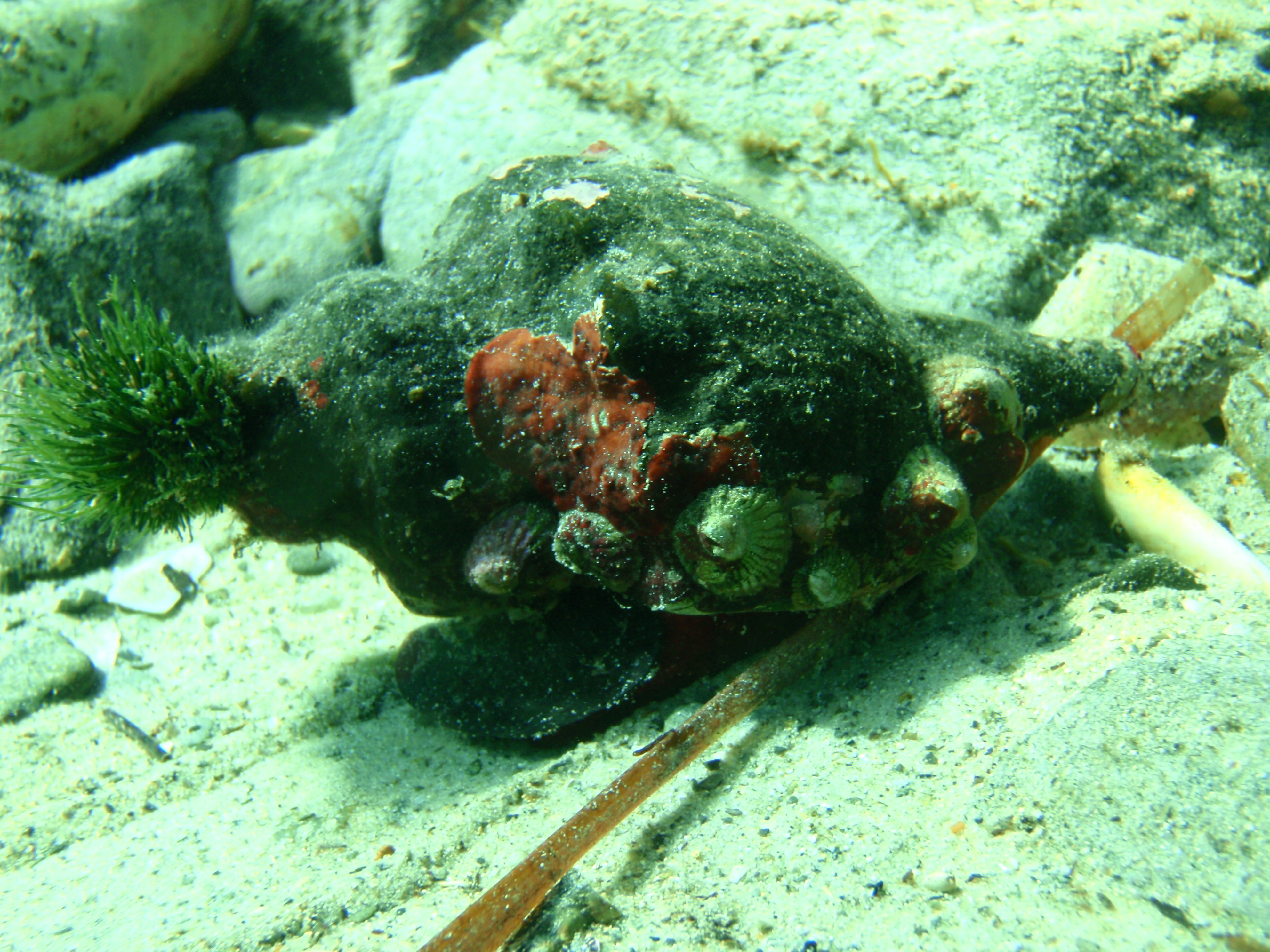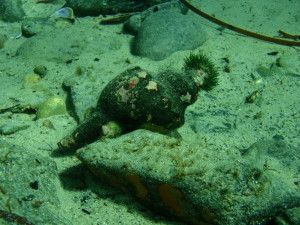Bernard C. Cotton was a Curator of Molluscs at the SA Museum in North Terrace, Adelaide, South Australia.
According to “Australia’s Spectacular Cowries” by Barry Wilson and Peter Clarkson (mlssa 1069), Bernard “wrote many scientific papers and semi-technical articles on southern Australian molluscs.”
According to “Kingdom of the Seashell” by R.Tucker Abbott, Bernard wrote three volumes of a South Australian identification guide titled “South Australian Mollusca” from 1940-1961.
According to “Fishes and Shells of the Pacific World” by John T Nichols and Paul Bartch, Bernard wrote the two-part series titled “The Molluscs of South Australia”, with Frank K Godfrey, from 1938-1940.
We have a copy of “South Australian Shells” by Bernard C. Cotton, published by The South Australian Museum, July 1976 in our Society library (mlssa 1015). It is a reprint of the 5th edition published in February 1963. The first edition was published in February 1946.
In 1931, Bernard wrote an article titled ‘Strange Creatures Which Live in Shells’ for The Mail newspaper. It can either be found on page 7 of The Mail of Saturday 26th September 1931 or at http://trove.nla.gov.au/newspaper/article/61564352 .
We present the article here below as an example of the knowledge of shells around 1931: –
“STRANGE CREATURES WHICH LIVE IN SHELLS
Many Varieties Found Along Adelaide Beaches
(By B. C. Cotton, Conchologist at Adelaide Museum)
In this article some interesting facts and peculiarities are described of that large and varied class of animal, the shells of which can be seen along the Adelaide beaches and in suburban gardens. This class includes the oyster, cockle, cuttlefish, squid, and snail.
Life of the Oyster
Shellfish are a favorite food of the Australian native. The discarded shells are often seen strewn about native camp sites. Among the debris left by the ancient cave man were stone implements used to force open the shells of oysters. Similar stone knives, it is said, are used by the Australian aborigines. Aristotle, the Greek philosopher, who lived about 350 B.C., incorrectly concluded that the oyster grew from mud. Pliny, the elder, attributed many medical properties to this ‘shellfish.’ Beaten up in a raw state he recommended them as a cure for chilblains, but it is doubtful whether the remedy was used with any success. The consumption of large quantities of oysters during what has been termed the gastronomic age of Rome was deemed something of an accomplishment, for a Roman Emperor, Aulus Vitellius is said to have eaten 100 dozen at a sitting. The shell of the oyster consists of two parts joined at the front by an elastic hinge. This hinge would force the shell open were it not for a strong muscle inside it. When this muscle is cut or relaxed, the shell is forced open by the elastic hinge. The ”beard’ or fringe which can be protruded is really part of the ‘mantle’ a skin which envelopes the animal and also forms the shell. Like a fish, the oyster is provided with gills, and these are enclosed within the mantle. More than a million eggs are laid by each oyster during a season, but only a few of these ever become adult oysters. The eggs are small, pear shaped, about one-five-hundredth of an inch long. After passing through a free swimming stage and arriving at an age of about 14 days the young oyster permanently attaches itself to a rock, shell, stick, or other object, and there spends the rest of its life. It takes three years for the oyster to reach a size suitable for market. The Port Lincoln oyster retains the eggs in the mantle for a longer time than the Sydney Rock. The latter will live from two to three weeks out of water, but the former dies in a few days.
Cuttlefishes
The white, fragile ‘cuttlebone” is a common sight on our beaches. Six different kinds of cuttlebones may be found on South Australian beaches and about double that number on the North Australian. They are the internal ‘shell” or ‘backbone’ of the cuttlefishes and are very light owing to their cellular structure. The chalky thickening of the ‘cuttle-bone’ is used in the manufacture of dentifrice, for taking impressions of objects, as a beak sharpener for caged birds and has recently been successfully employed experimentally for packing fruit. The cuttlefish is a close relative of the octopus, nautilus, and squid. It has eight aims beset with suckers on their inner surface, and two tentacular arms which it can lengthen and retract, and are used for stretching out to seize a prey. The mouth is provided with a pair of parrot-like beaks with which to tear its victim. These beaks are responsible for the formation of ambergris. The cuttlefish and its relatives are the chief article of food of the sperm whale. The beaks become lodged in the whale’s stomach and there set up an irritation, which results in the formation of ambergris. All specimens of ambergris have these beaks embedded in them. This valuable product of disease is worth about £4 an oz. A large specimen of a South Australian cuttlefish in the museum measures nearly three feet long. The squid has a transparent quill-pen shaped backbone in place of the cuttlebone. These animals are occasionally sold for food in some Adelaide fish shops.
Chitons
Another form of shell-bearing animal is the chiton, or coat of mail shell, on which Mr. Edwin Ashby, of Blackwood, is a well-known authority. These chitons may be found attached to rocks at Marino and other parts of our coasts. In fact, Marino is said to be one of the richest places in the world for chitons. This kind of shellfish has eight shelly plates held together by a leathery girdle. When the animal dies and the girdle decays, the plates become separated when they are known as ‘butterfly” and ‘toe-nail’ shells. Although there are hundreds of different kinds of chitons, all have eight plates, except in abnormal or diseased form, where two or more plates may be fused together. They then appear to have only seven or six.
Snails
The common garden snail so destructive in its habits is a too familiar sight. Like a few more less common snails found in our garden, it was imported from Europe, and seems to have found the new home very much to its liking. It has propagated enormously, not only in Australia, but in many other countries to which it has been introduced. In England, the snail is preyed upon by the glow-worm, which paralyses and then eats its victim. The snail damages vegetation by means of its ribbon-like ‘tongue,’ beset with small, triangular teeth, which it scrapes to and fro on the surface of leaves and other parts of plants. A less common horn-colored, white streaked snail also imported from Europe is frequently brought into the museum for identification. Nearly all the spiral type of ”shellfish.’ marine, land and freshwater, have this ‘tongue.’ Although it is absent in the kinds which are parasitic on sea urchins and holothurians.
‘The Daily Mail.’ London, recently published a message from Basra. Irak, stating that snails compelled the Royal Air Force to abandon its base at Lake Habbanya. near Bagdad. The site of the intended camp was found to swarm with myriads of snails, which carried germs of the disease Bilharziasis, which British troops during the war dubbed ‘Bill Harris.’
Some Other Shells
The ”liver fluke.’ a worm which causes ‘liver rot’ in sheep, spends its early life as a parasite in a freshwater snail. The elimination of certain species of snails is therefore the first step towards preventing these diseases.
The green-striped turbo is a common sight on our beaches. Seagulls grasp this in the beak and, after carrying it to a great height, let it fall. The impact on the beach breaks the shell, and the bird is able to consume the contents.
The New Guinea natives make a hole in the side, near the apex of the ‘triton,’ thus forming a loud trumpet.
The ‘trochus,’ found on the Barrier Reef. is used in the manufacture of pearl. Valued at about £20 a ton. £23,000 worth of this shell was sold in 1916.
From the same locality come the ‘Diana’s ear’ and the slender-spined murex. Bednall’s murex is a rare North Australian species named after the late Mr. W. T. Bednall, a well-known Australian conchologist. There are about 2,000 different kinds of snails in South Australia, and possibly twice that number in North Australia.”


